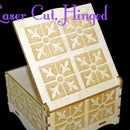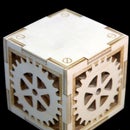Introduction: Small Laser Cut Wooden Box (2.5x2.5)
I made several of these small, wooden boxes a few years back to give out as Christmas presents to some of my co-workers. It needed to be large enough to be somewhat useful for storage (after they ate the candy that was in them :) but small enough that I didn't break the bank giving them away. The etched design was another I found among old woodworking designs.
Step 1: Materials/Tools List
- Cut File and Access to a Laser Cutter/Laser Cutting Service. I have access to a 50 watt laser using Adobe Illustrator. So the file I created is .ai format and color-coded for the laser's software, but I'm sure it can be modified to work on a different brand if needed.
- One 12" x 12" sheet of 1/8" (3mm) thick Craft Plywood or MDF
- Wood Glue or Superglue
- 120 Grit Sand Paper
- Masking or Clear Tape
- Orange Hand Cleaner
- An Old Toothbrush
- Paper Towels or a Shop Cloth
Attachments
Step 2: Parts Inspection and Cleaning
You should have a total of ten pieces: four sides, a bottom (with my maker's mark), and four strips for the edge of the lid and the top lid panel.
Lay all of your parts out and inspect them for problems with the material. The parts are usually too sticky to work with when they are freshly cut and I find that it helps to wait a day until the sap/resins dry.
Clean the laser burn and residual sticky goo off of the parts with a Shop Cloth or Paper Towel dabbed in Orange Hand Cleaner. The same can be used to clean the design etched into the surface, but using an old toothbrush will allow you to get all of the finer detailed areas. Any burn marks on the higher surface will be removed when you sand the parts.
The Orange Hand Cleaner will leave residue behind. Blot it off with a damp cloth or paper towel so the residue will not interfere with the finish later. Make sure the cloth isn't too wet or it can cause the wood grain to swell and possibly warp your parts, then set the parts aside to dry.
Step 3: Dry-Fit the Parts Together
Once all of the parts have been cleaned and are dry, try dry-fitting them together. Dry-fitting will give you an idea of whether or not all of the tabs/slots and finger joints fit or need enlarging and if the parts fit together thickness-wise.
As I've mentioned in previous Instructables, even if the material is labeled as 1/8"/3mm thick, it is often times actually thicker. How much the thickness is off depends on the manufacturer. So dry-fitting will help you determine how much surface area you need to remove (if any).
MDF is usually more accurately labeled, but I only recommend it if you plan on doing a metallic finish as MDF is a bit more fragile than plywood. MDF will give you a smoother surface than wood and an overall better metallic effect, though.
The Lid of this project is designed to lift off like a shoe box lid. Hold or tape the pieces together and see if it will slip easly on and off of the box. This will also tell you how much the body of the box needs sanding for thickness.
Step 4: Enter the Sandman
The parts will need sanding for appearance, at least. If you find that your parts don't need heavy sanding to thin the material, rejoice!
If your material is a bit too thick and you have to sand it thinner, sand equally from the front and back surfaces and make sure to keep checking the fit (and the fit of the lid, in necessary) as you go. You can always do a final sanding of the outside of the box once it is glued together.
If you choose to use an orbital sander, make sure you have a steady hand and a very strong grip to avoid accidentally sanding off your fingertips or over sanding the parts. It's usually safest to hand sand the surfaces by laying a whole sheet of sandpaper on a flat surface and sliding the material back-and-forth on it.
Step 5: Stuck Like Glue
Once the surfaces are all sanded and the parts fit together nicely, use an old toothbrush to clean all of the sanding dust off of the parts.
I recommend using wood glue to glue wood and Superglue for gluing MDF. As mentioned in my previous Instructables, if you plan on staining your wooden box later with wood stain, any drips of wood glue can be chipped off or sanded away after it dries; Superglue spreads into the surface and acts as a barrier that doesn't allow stain to penetrate properly. So if using Superglue, I recommend Thick or Medium, at the very least, to minimize the threat of soaking into the surface.
Pick one Side panel and slip the Bottom into place. Do not glue it, so it can expand and contract. Then apply glue to the finger joints along one edge of the Side panel and fit a second Side panel in place,adding a piece of Tape to hold the glued joint. Repeat for the third and fourth Side panels, securing with Tape as you go. After it is all taped, set it aside and assemble the Lid.
Step 6: Lid Assembly
Spread glue onto one edge of the Lid panel making sure to get both sides of the finger joints and tape one of the side edges in place. Repeat for the remaining three edges, making sure to tape them all as you go. Flip the lid over and lay it on a flat surface so it can dry upside-down. Drying time depends on the glue you use.
Step 7: Finished!
Once the glue has dried, remove all of the tape and check for globs or runs of dried glue to sand off.
You should now be ready to apply a finish your box! Whatever finish you choose is entirely up to you, whether wood stain, pain or just varnish. I do recommend lining it with felt or velvet after any finish is applied.
I can add tutorials on different finishing techniques, from metallic faux finishes to stained and varnished wood finishes and lining, if there's any interest, or you can make one and share your finishing tips on Instructables!
As always, be safe and have fun!

Participated in the
Makerspace Contest

Participated in the
Wood Contest 2016














